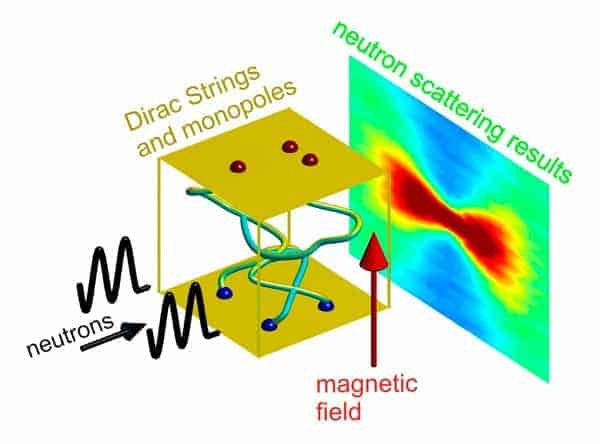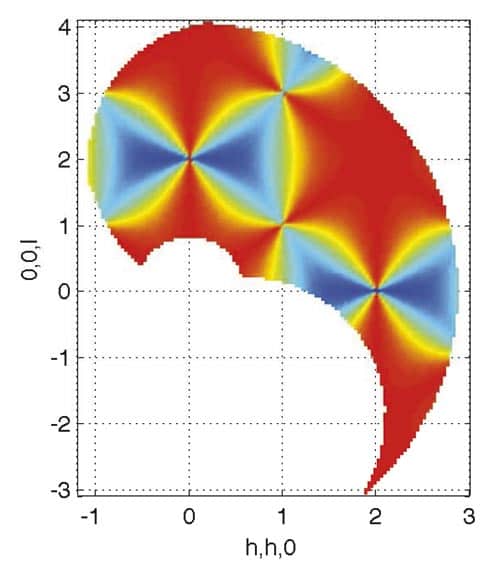
Ever since magnetic monopoles were first predicted by Paul Dirac in 1931, physicists have looked in vain for these elusive entities in everything from particle accelerators to Moon rocks. Now, two independent research groups claim to have caught sight of monopoles – essentially magnets with only one pole – in magnetic materials called spin ices.
The spin-ice monopoles have very different origins from those predicted by Dirac’s work on quantum electrodynamics and therefore their discovery is unlikely to help physicists develop grand unified theories of particle physics or string theories. But because the monopoles occur in magnetic materials, understanding their properties could help with the development of magnetic memories and other spintronic devices.
International collaborations
One team included Tom Fennell and colleagues at the Institute Laue-Langevin (ILL) in France along with physicists in the UK. The other included Jonathan Morris and colleagues at the Helmholtz Centre in Berlin (HZB) along with scientists in the UK, Argentina and Germany.
The Morris group studied the crystalline material Dy2Ti2O7, which has a tetrahedral unit cell with two Dy spins pointing into the centre of the tetrahedron and two pointing out. It is called a spin ice because the arrangement of spins is similar to that of hydrogen atoms in frozen water.
The spins in a spin ice do not line up like those in a ferromagnet. Instead physicists believe that they join up to create magnetic flux lines within the material that resemble a knotted mess of strings. These are known as Dirac strings because they resemble the tubes of flux that should connect magnetic monopoles according to Dirac’s calculations.
If the spin configuration of an individual tetrahedron is disrupted – say, by flipping a spin from “out” to “in” – a string is broken and the magnetic flux spills out in a manner resembling a monopole.
Morris and colleagues applied a magnetic field to their spin-ice sample and found that the stings began to break into finite sections that line up along specific directions in the material. This was revealed by firing a beam of neutrons at the sample and studying the interference pattern that results when the neutrons (which have magnetic moments) scatter from the strings.
Each finite string has a “north” and “south” end and physicists believe that under certain conditions the length of the string can change easily. As a result, the ends of the string will appear to behave as two individual “quasiparticles” – north and south monopoles.
While the Morris group was able to ‘see’ the Dirac strings with neutrons, they inferred the existence of monopoles by measuring the heat capacity of the spin ice. Physicists had calculated that at temperatures of around 1 K the heat capacity of a spin ice should resemble that of a gas of magnetic monopoles – which is exactly what Morris and team saw.
Pinch points to Coulomb phase

Meanwhile at the ILL, Fennell and colleagues used a beam of spin-polarized neutrons to study a similar spin ice – Ho2Ti2O7. They were particularly interested in studying the ground states of the spin ice to establish if they can indeed support monopole excitations. At low temperatures and zero magnetic field, physicists had predicted that, in order to have monopoles, this knotty mess of a state must be a “magnetic coulomb phase” – which the team confirmed through the observation of “pinch points” in their neutron scattering data.
In the absence of finite strings and monopoles, the pinch points are very sharp. However at temperatures of around 1 K the thermal excitation of monopoles creates finite strings, which broaden the pinch points – which is what the researchers saw in their neutron diffraction data.
Fennell told physicsworld.com that the team is now trying to measure the width of the pinch point, which should give the length of the Dirac strings. Meanwhile, the Morris group is busy measuring the heat capacity of its spin ice as a function of applied magnetic field – which should provide further insight into the magnetic monopoles.
Oleg Tchernyshyov at Johns Hopkins University in the US said that the findings of both teams are in agreement with a theory (see “‘Spin ice’ could contain magnetic monopoles”) that was unveiled last year by several of Morris’s colleagues. However, he cautions that the theory and experiments are specific to spin ices, and are not likely to shed light on magnetic monopoles as predicted by Dirac.
One important general result of the research, according to Morris, is that the spin ice monopoles are one of the first examples of “fractionalization” – whereby a spin is split into two separate entities – in a 3D system. A familiar 2D example of fractionalization is the fractional quantum Hall effect, the discovery of which resulted in Robert Laughlin, Horst Störmer and Daniel Tsu winning the 1998 Nobel Prize for Physics. Because this and other properties of spin ices should be shared by similar magnetic materials, it could lead to the development of new materials for making spintronics devices, such as magnetic memories.
The research is published in Science Express.



